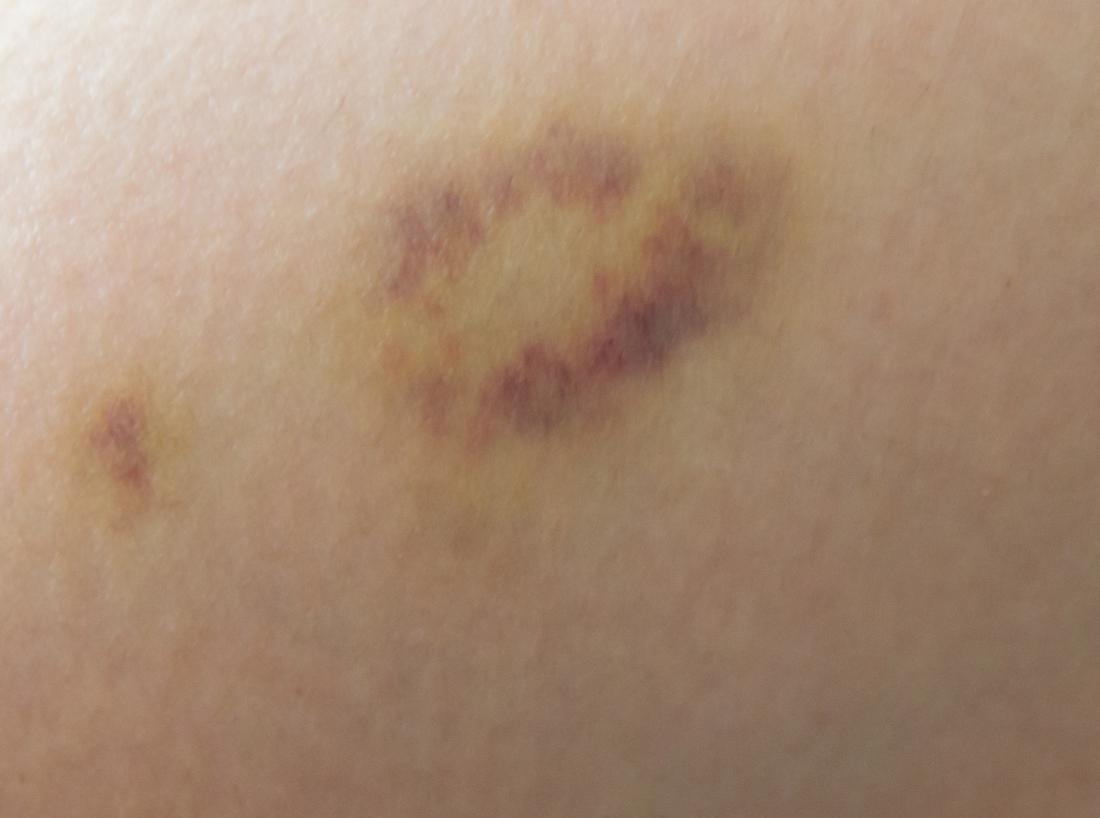We include products we think are useful for our readers. If you buy through links on this page, we may earn a small commission. Here’s our process.
Medical News Today only shows you brands and products that we stand behind.
Our team thoroughly researches and evaluates the recommendations we make on our site. To establish that the product manufacturers addressed safety and efficacy standards, we:- Evaluate ingredients and composition: Do they have the potential to cause harm?
- Fact-check all health claims: Do they align with the current body of scientific evidence?
- Assess the brand: Does it operate with integrity and adhere to industry best practices?
Yellow bruising may appear on the breast for a number of reasons. These can include trauma, breastfeeding, or surgery.
Developing a yellow bruise on the breast is not usually a cause for concern. It tends to mean that a person has had a blow to the breast.
This article looks at why a yellow bruise might appear on the breast, some treatment options, and whether or not a person should see a doctor.

About 7–10 days after an injury to the breast, a bruise may appear yellow.
Developing a yellow bruise on the breast indicates that an injury or trauma to the breast tissue has occurred, usually about 7–10 days ago.
Not everyone who experiences breast trauma will notice the yellow stage of a bruise. For example, the coloring may not show up in darker skin.
What do the colors of a bruise mean? Learn more here.
Trauma
Bumping into an object or sustaining a minor sports injury is enough to cause a bruise. More severe traumas, such as being in a vehicle accident or having a fall, can also cause bruising.
Some people bruise more easily than others. An injury that may cause a bruise in one person may barely leave a mark on another.
Older adults and those with fair skin are more likely to bruise. People who have a condition or use medication that increases the risk of bleeding mean may also bruise easily.
Breast bruising can also occur as a result of
Alternatively, a person can call the National Domestic Violence Hotline on 1-800-799-7233 or TTY 1-800-787-3224. All calls to this number are free of charge.
Breastfeeding
Breastfeeding can sometimes cause bruising, especially if the infant grabs or squeezes the breast tissue while nursing. Pumping can also occasionally cause bruising around the nipple if the flange, or the part that attaches to the breast, is the incorrect size.
If bruising results from breastfeeding, a person should speak to a lactation specialist, as they may be able to fit a more suitable flange or ensure that the baby’s latch is correct.
Surgery
Bruising is also common after breast surgery. Some bleeding is likely to occur during esthetic surgery or the removal of a breast lump. Even smaller procedures, such as a breast biopsy, can lead to bruising during the recovery process.
The doctor or surgeon will advise a person on what to expect regarding bruising after surgery.
Other causes
Some serious conditions can lead to easy bruising, although not specifically on the breast.
They
- senile purpura, a condition that can affect older adults
- the use of some mediations, such as blood thinners
- von Willebrand’s disease
- easy bruising syndrome, or purpura simplex
- low levels of vitamin C or vitamin K
- vasculitis, or inflammation of the blood vessels
- some gastrointestinal conditions
- hemophilia
In this article, learn about more serious conditions that can lead to easy bruising.

Research suggests that a blow to the breast does not increase the risk of developing breast cancer.
Skin changes, such as inflammation or puckering, can be a sign of some types of skin cancer. However, yellow bruising is not a sign of cancer.
In the past, experts have raised the question of whether a breast trauma might
Some older studies have suggested that this is possible. However, the American Cancer Society note that although a blow to the breast may result in a lump, it
Ordinary bruises are usually easy to manage at home. In the sections below, we look at some home remedies for bruising:
Ice
It may help to apply an ice pack to the bruise. To do so:
- wrap some ice in a towel or cloth
- apply it to the bruise for about 10 minutes
- repeat as necessary each day until the bruise fades
Arnica
A
Arnica is an herb based medication that is available over the counter or for purchase online.
Pain relief medication
Acetaminophen or ibuprofen can relieve pain and swelling. People with bruises should avoid taking aspirin, however, as it can make bruising worse.
Bruising is not the only skin change that can occur in the breast tissue. Some skin changes are minor, whereas others can signal a more serious condition.
In the sections below, we discuss what other skin changes can affect the breast:
Fungal infections
A fungal infection can develop in skin folds under larger breasts. Moisture can collect under the breast and cause redness and itching.
Tips to help prevent this include:
- keeping the area clean and dry
- using an over-the-counter fungal cream or spray powder
Contact dermatitis
Contact dermatitis is an allergic reaction that can happen when the breast tissue comes into contact with an allergen.
Common allergens include:
- soaps
- lotions
- perfumes
- creams
- laundry detergents
Treating contact dermatitis involves identifying and removing the allergen. It may take some time to identify which substance is causing the problem.
Cellulitis
Cellulitis is a bacterial infection of the skin and the underlying tissue. Sometimes, an abscess, or mass, can form. This is a deeper infection.
Symptoms include:
Anyone with symptoms of cellulitis should see a doctor as soon as possible, as it can worsen over time and lead to further complications.
A doctor will treat cellulitis with antibiotics. If a deeper infection or abscess occurs, a healthcare professional may need to drain it.
Mastitis
Mastitis is an infection of the breast tissue. It commonly occurs during breastfeeding.
Symptoms include:
- swelling
- redness
- pain
- fever
Home remedies can often relieve mastitis, but in severe cases, a doctor might prescribe antibiotics.
Anyone who is breastfeeding should ask a doctor before using medications to treat mastitis or any other condition, as they may affect the breastfeeding infant.
Learn more about why mastitis happens, and how to treat it, here.
Paget’s disease of the breast
In Paget’s disease of the breast, a rash appears on the skin of the nipple and the areola, which is the darker skin around the nipple. It may indicate a rare type of breast cancer.
Around
The symptoms include:
- yellowish or bloody nipple discharge
- flaking or crusting of the skin on or around the nipple
- itching or tingling of the nipple or areola
- a change in the appearance of the nipple
Paget’s disease is rare, and the symptoms often mimic eczema. For these reasons, it can be hard to diagnose.
Inflammatory breast cancer
Inflammatory breast cancer is a rare and aggressive form of breast cancer that causes a blockage of the lymph vessels in the breast. It accounts for
The breast(s) will appear:
- swollen
- red
- inflamed
In some cases, the skin takes on a pitted appearance that resembles orange peel. This type of cancer does not always cause a solid tumor or lump within the breast.
Not all breast cancers involve a lump. Learn more about other signs to look out for.
Colors of a bruise
The colors of a bruise change over time.
At first, most bruises will be
After 1–3 days, they may be blue, purple, or black. From 7–10 days, they can turn greenish before fading to yellow. In darker skin, a bruise is usually purple or black.
A yellow bruise usually means that a person sustained an injury around 7–10 days before.

A person should talk to their doctor if there is a lot of bruising on the breast.
People can usually manage yellow bruising of the breast at home. However, a person should speak to a doctor if:
- They have a lot of bruising.
- They cannot recall what caused the bruising.
- Menstruation is heavy and lasts a long time.
- The bruise does not go away within 2 weeks.
- There is frequent bleeding from the nose or gums.
- A small cut bleeds a lot.
- There is blood in the urine or stool.
- There is a family history of easy bruising or excessive bleeding.
These factors can signal the presence of a blood clotting disorder or another serious complication.
Other problems that may need medical attention are:
- a large lump that accompanies a bruise, as this may need draining
- redness or swelling around a bruise, which may indicate an infection
People who experience any of these symptoms should see their doctor to rule out other conditions.
Anyone who notices a change to their breast tissue that they cannot explain should talk to a doctor. However, most people will not need to see a doctor about a yellow bruise on the breast.
Most bruises are not a cause for concern, and people can treat them at home. However, if they have concerns about excessive bruising or bleeding, they should see a doctor.
Some people, such as athletes, may be more likely to experience breast trauma, bruising, and possibly a lump. A blow to the breast does not increase the risk of cancer.
However,
